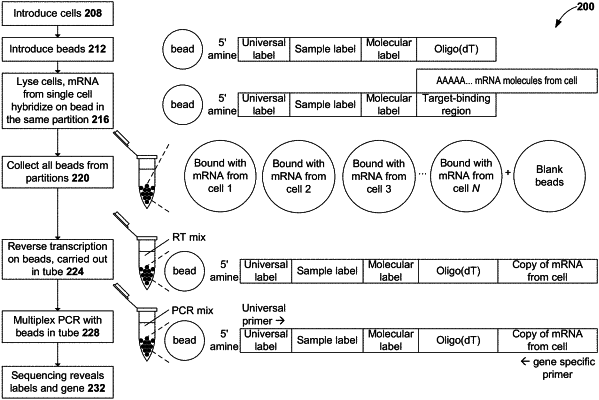| CPC C40B 30/04 (2013.01) [C12N 15/1065 (2013.01); C12N 15/1072 (2013.01); C40B 40/10 (2013.01); C40B 50/06 (2013.01)] | 18 Claims |

|
1. A method for simultaneous measurement of protein and gene expressions in cells, comprising:
contacting a plurality of first cellular component-binding reagents with a plurality of cells comprising a plurality of first cellular component targets, a plurality of second cellular component targets, and copies of a nucleic acid target, wherein each of the plurality of first cellular component-binding reagents comprises a first cellular component-binding reagent specific oligonucleotide comprising a third universal sequence and a unique identifier sequence for the first cellular component-binding reagent, and wherein the first cellular component-binding reagent is capable of specifically binding to at least one of the plurality of first cellular component targets;
contacting a plurality of second cellular component-binding reagents with the plurality of cells, wherein each of the plurality of second cellular component-binding reagents comprises a second cellular component-binding reagent specific oligonucleotide comprising a second universal sequence and a unique identifier sequence for the second cellular component-binding reagent, and wherein the second cellular component-binding reagent is capable of specifically binding to at least one of the plurality of second cellular component targets, and wherein the second universal sequence and the third universal sequence are different;
barcoding the first cellular component-binding reagent specific oligonucleotides with a plurality of oligonucleotide barcodes to generate a plurality of barcoded first cellular component-binding reagent specific oligonucleotides each comprising a sequence complementary to at least a portion of the unique identifier sequence;
barcoding the second cellular component-binding reagent specific oligonucleotides with the plurality of oligonucleotide barcodes to generate a plurality of barcoded second cellular component-binding reagent specific oligonucleotides each comprising a sequence complementary to at least a portion of the unique identifier sequence;
barcoding copies of the nucleic acid target with the plurality of oligonucleotide barcodes to generate a plurality of barcoded nucleic acid molecules each comprising a sequence complementary to at least a portion of the nucleic acid target;
generating a sequencing library comprising a plurality of nucleic acid target library members, a plurality of first cellular component target library members, and a plurality of second cellular component target library members, wherein generating the sequencing library comprises:
attaching sequencing adaptors to the plurality of barcoded nucleic acid molecules, or products thereof, to generate the plurality of nucleic acid target library members; and
attaching sequencing adaptors to the plurality of barcoded first cellular component-binding reagent specific oligonucleotides, or products thereof, to generate the plurality of first cellular component target library members; and
attaching sequencing adaptors to the plurality of barcoded second cellular component-binding reagent specific oligonucleotides, or products thereof, to generate the plurality of second cellular component target library members; and
obtaining sequencing data comprising a plurality of sequencing reads of nucleic acid target library members, a plurality of sequencing reads of first cellular component target library members, and a plurality of sequencing reads of second cellular component target library members.
|